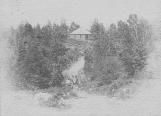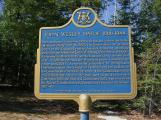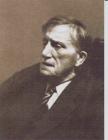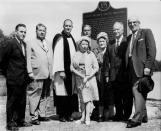1
John Wesley Dafoe was born in March 9, 1866, the third child of Calvin Wesley Dafoe and Mary (Elcome) DafoeThough the farm where he was born was on lot 19, concession 9 in what is now called Whiteduck Lake Rd in Hastings County, he always considered Combermere, the closest village about three miles distant, as his birthplace and home town. A cabin built by him at Ponemah Lake, Winnipeg where he planned, later in his life, to write his memoirs was to be called 'Combermere', but to his disappointment he discovered that a neighbour, nee Meda Yandeau from Combermere, had already chosen the name ahead of him.
There is some question as to whether his ancestors were Flemish or Dutch. There were several spellings of the name: Deffaux, Default, Devas among them, but early in the 17th century they settled with a group of Dutch immigrants in New York State and spoke Dutch. There the name passed through many changes, but the branch to which John W. Dafoe belonged called themselves 'Dafoe' and are so recorded in the Regimental Records of the United Empire Loyalists (U.E.L ), though in one place the name is spelled Defoe. The original spelling was Devos. Mr. Dafoe, after some research made rather difficult by the passage of three hundred years, came with to the conclusion that the Dafoes were Dutch in origin.
3
During the War of Independence, the Dafoeís moved to Canada, settling on the lands allocated to the U.E.L in he county of Prince Edward, near Belleville on the eastern side of Lake Ontario. Their farm was at Adolphoustown , but some of the family later moved to Zion Hill in the county of Turlow, nine miles north of Belleville. Here, Calvin Wesley Dafoe, the father of John Wesley Dafoe, was born. Two of his brothers became doctors, but Calvin Wesley was the farmer of the family.Johnís mother, Mary Elcome was born in Kent, England. Her mother died when she was fourteen, and so the responsibility of taking charge of four younger sisters and a brother fell on her young shoulders. When she was seventeen, her father being a non-conformist, decided that Canada offered him and his small brood greater opportunities for the future. So early in 1857, he booked passage on a sailing vessel bound for Canada carrying steel rails and materials for the construction of the Victoria Bridge in Montreal (which was to span the St. Lawrence River at Mount Royal). It was a trip of endurance taking six weeks for the passage, the ship having to battle strong winds and stormy seas practically all the way. They too settled at Zion Hill near Belleville.
When Calvin Dafoe married Mary Elcome, he brought her home to his family and there they stayed until after their first two children were born, William in 1862 and Margaret in 1864. By this time they had decided to strike out for themselves, so they moved in May 1865 one hundred miles north to the beautiful Ottawa Valley, taking a homestead on a large tract of land that had recently been opened up. Maryís father also made the change.
There, John Wesley Dafoe, their third child was born. During the years that followed, six other children joined the ranks: Edith, Eve who died in infancy, Wallace, Calvin, Eddie and Runce. Wallace and Bruce chose newspaper work as a profession, Wallace later retiring from it to buy a fruit farm in Penticton, BC; William and Calvin were farmers, though in latr life Calvin became a contractor and builder. Eddie died in his late teens; Margaret amnd Edith married farmers. In 1886, John Wesley took up a homestead for his family in the Killarney District and he family moved there in 1887.
4
It was humble home where John Dafoe was born, a log cabin in the backwoods, with logs hewn out of the surrounding forest - one large room partitioned by quilts, chairs made from tree limbs, a pinic-style table and a stone fireplace. There were others who had made the trip to the Ottawa Valley, and so there were a few neighbours in this wilderness. The men farmed in the summer and hewed logs in the winter.6
Young John, who had a keen interest in nature, used to wander among the trees and underbrush searching for flowers, birds and animals. One day as he trudged off to the Purdy School he came face to face with a bear. John arrived at school a bit breathless but unscathed. Not even a bear could keep him from school.There were other exciting adventures.... like when the chimney was being repaired, a wildcat decided to make his entrance through the hole, and Johnís mother stood on a chair holding a pillow in the opening until the intruder could be attended to.
There was only one steel needle in the settlement, owned by Mrs. Dafoe. It was a precious possession carefully guarded by always being pinned in a cloth which could be safely transported from one home to another if needed by a neighbour. One day, Mrs Dafoe was busily sewing when a fire broke out in the neighbourhood. In the excitement, the needle was dropped..... a desperate situation for the women of the community. It eventually was found, but Mrs. Dafoe always said, 'Talk about looking for a needle in a haystack!'
Johnís mother, a most intelligent and discerning woman, realized when John was six, that he was a lad of exceptional ability. So she made up her mind then and there that he should have all he schooling she could manage to provide for him. It was a difficult decision to make for the boys were expected to do the chores and work on the farm. Johnís mind was always on his books. One neighbour remarked, 'John Dafoe is the laziest boy in two counties' A snap judgement it there ever was one!
When John was nine he was sent to live with his grandmother at Thurlow to attend school. News traveled slowly in those days, and when he arrived he discovered that his grandmother had died. A young aunt and uncle were the only occupants of the home.....too young to be responsible for a small boy. He was alone much of the time, and often arrive home to a locked house, the only means of entrance being to crawl through a window. The news of his grandmotherís death finally reached his other, so young John returned home.
His parents decided to send him to school in Arnprior, so off he went to live with an uncle Edwin Elcome. It was quite a journey for a small boy..... a long drive to Renfrew by horse and cart and then by train to Arnprior. Here he attended public and high school, completing his formal education.
At intervals he taught for sort periods to help pay for his schooling. At his first school his teaching was abruptly ended when a parent wrote to the School Board complaining about his age. There are conflicting reports as to whether he was fourteen or fifteen at the time.
8
At the age of sixteen, he taught at Bark Lake some thirty or forty miles north of his home in the heart of the timber district. Here he discovered a treasury of books and pamphlets left behind by a previous teacher. These were avuidly read night after night, by the light of a single candle deposited in the centre of the kitchen table, (As no extra candles were allowed by the landlady) This shelf of books opened up a new world which greatly influenced his thinking in the days to come. This self education continued until the day he died.At seventeen, John Dafoe entered the realm of journalism. Hhe was back at his desk in the high school when a notice in the weekly 'Star' advertising for a man of high ambition caught his eye. He forthwith sat down and applied for the position. Upon receiving a reply promising to give him a trial, he set out on the first rian for Montreal, walked into hte 'Dstar' off ice and approached Mr. OíConnor. Here is Mr. Dafoeís own description of the interview:
'He looked at me a little surprised and puzzled for a while. 'Yes', he said, 'We will give you a trial. You do not know the city very well; we will give you some inside work so in a place of being Cub Reporter I became a sub editor at six dollars a week'
Earl in January, he was sent up to Ottawa as Parliamentary Correspondent for the 'Star', a position he held for two years. It was during this period that John W. Dafoe, brought up in a Tory family, though at seventeen not having any set politics, became a fighting Grit, (converted and swept off his feet by the eloquence of Edward Blake)
When the 'Ottawa Journal' was founded in 1885, John Fafoe became editor of this paper for about five months, resigning when he realized that the responsibilities were too great for a youth of nineteen.
The year 1886 found him in Winnipeg working as a reporter under the guidance of W.F. Luxton, editor of the 'Manitoba Free Press' (now the Winnipeg Free Press)
In 1890 he married Alice Parmelee, daughter of W. G. Parmelee, Deputy Minister of Trade and Commerce with the Federal Government. Of this union, five offspring survive: Mary, Edwin, Dorothy, John and Marcella. William and Sidney died in infancy. Van in 1959, Elizabeth in 1960. Mrs Dafoe is now ninety-four (1971)
In 1892 John returned to Montreal as editor of the 'Montreal Herald' for a period of three years, moving from there back to his first love, the'Star'. But in 1901, Clifford Sifton offered him the editorship of the 'Free Press', an offer quickly accepted. Here he remained until his death in 1944.
9
John W. Dafoeís ability was widely recognized. He gave willingly of his knowledge whenever and wherever it was needed, accepting many responsibilities, some of which are listed here;-He was a member of the Imperial Press Conference in 1919,
-He was one of the official representatives of the Department of Public Information from 1934 - 1936,
-President of the Canadian Institute of International Affaires..
-In 1934 he was appointed Chancellor of the University of Manitoba, a post he held until his death in 1944.
-From 1937-1938, he was Chairman of the Institute of Pacific Relations.
-From 1937-1938, he was a member of the Rowell-Sirois Commission on Dominion Provincial Relations.
He wrote numerous articles and pamphlets for publication and addressed many audiences covering a wide variety of subjects including:
-International Affaires
-Canadian Nationhood
-The Peace Conference
-The League of Nations
-The Constitution
-Economics
-Foreign Policy
-Freedom of Public Opinion, etc.
During his busy life he managed to write and publish the following books:
-Over the Canadian Battlefields
-Laurier
-A Study in Canadian Politics
-Clifford Sifton In Relation to His Time
-Canada: An American Nation
He also edited the following:
-Canada Fights
-An American Democracy at War
Many honours were bestowed upon him:
-He was a Fellow of the Royal Society of Canada.
-An L.L.D. from the following universities: Manitoba, Queens, Alberta and North Dakota
-Columbia University bestowed upon him an Honourary Degree of Doctor of Literature.
On January 8th, 1944 he was at his desk as usual. Early Sunday morning on that date, he complained of feeling ill, and on route to the hospital he died of a heart attack. His death was sudden and unexpected, but a wish close to his heart had been fulfilled; to die 'in harness'.
11
Pictured left to right:Elgin Oram - Reeve of Bangor, Wicklow & McClure Twps.
C. T. Collins - M. P. P. Hastings Co. East
Rev. David Lethbridge - Incumbent Priest of St. Paulís Anglican Church, Combermere
Miss Dorothy Dafoe - Daughter of John Wesley Dafoe, Winnipeg, MB
Frank Walker - Montreal Family Herald
Miss Kathryn Farmer - Teacher & Historian of Combermere
T. F. McIIwraith - Professor at University of Toronto and the Historical Sites Board
Victor DeMilis - President of the Madawaska Valley Regional Tourist Council
The plaque is now located at the John Wesley Dafoe Park overlooking Kamaniskeg Lake. It was relocated when the park was established at a later date.




